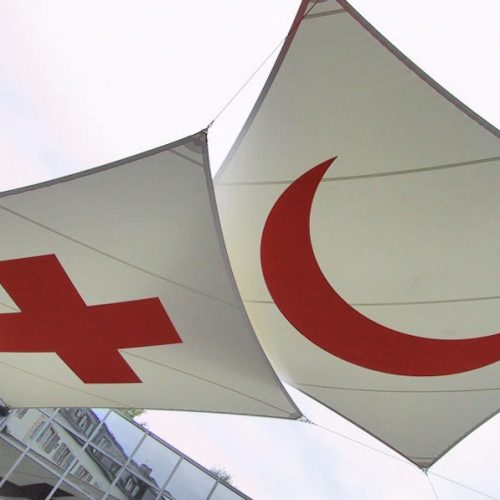The Egyptian Red Crescent was founded in 1912 by Sheikh Ali Yussuf with a clear Panislamic and anticolonial agenda.
In the following decades, however, the organization turned more secular and pro-Western, without giving up its Muslim roots and pro-independence aspirations. It was deeply influenced by local traditions of charity and philanthropy, and yet sought to connect to international humanitarian structures and standards, struggling for autonomy from the successive Egyptian governments. This contribution explores why founders and members of the Egyptian Red Crescent oriented towards international collaboration and which role religion in general and Islam in particular played in this process. Testing different theoretical frameworks this article follows the Egyptian Red Crescent’s history in the twentieth century, taking into account the impact of colonialism, nationalism and decolonization.
In much research on humanitarianism the International Committee of the Red Cross, founded in 1863, is generally considered the prototype of a Christian-inspired, Western humanitarian organisation (Forsythe 2005, 27-28). While this view is legitimate in many respects two points should be added: first, for a long time non-Western and in particular Muslim Red Cross and Red Crescent societies did not receive sufficient attention in research on the International Red Cross and Red Crescent movement. This only changed in the 1990s with the pioneering work of Jonathan Benthall and others (Benthall 2003). Second, this movement has played an important role in respective Muslim societies and considerably influenced the Swiss members of the movement. This is also true for the Egyptian Red Crescent.
Muslim and Secular – Founding of The Egyptian Red Crescent and its Religious and Political Philosophies
After the Ottoman Red Crescent, founded in 1869, the Egyptian Red Crescent was the second Muslim and first Arab Red Crescent society within the movement. While the Ottoman Red Crescent’s foundation happened mainly due to an International Red Cross initiative, the Egyptian Red Crescent was founded solely based on an Egyptian initiative. Its establishment in 1912 is even more surprising as the founder, Shaykh Aly Yussif, was a Pan-Islamic, anticolonial newspaper publisher with close connections to the Egyptian viceroy, Abbas Hilmi II. The initial reason for the Egyptian Red Crescent’s foundation was the Italo-Turkish War in Libya in 1911/1912. The Egyptian Red Crescent was meant to support the ‘Ottoman brothers’ and Muslim soldiers in their fight against the colonial invader. Thus, in this first phase of the Egyptian Red Crescent, humanitarian aid was often provided with reference to Islam as uniting donors and beneficiaries. It shared this feature with other charitable associations founded at the same time, such as, for instance, the Mubarrat Muhammad Aly.
In a second phase, the Egyptian Red Crescent turned towards Western and secular ideas. This was mainly due to its members who came from wealthy Egyptian land owners with close connections to the royal family. Many of the Red Crescent’s presidents were surgeons at the famous hospital Qasr al-Ayni and professors of the Faculty of Medicine in Cairo. Such a Western and secular orientation can also be observed with regard to the women of the Egyptian Red Crescent, the association’s most active members. Many of them were educated at foreign, mainly French schools in Egypt and wore Western clothes. However, this did not mean that they were in favour of the British occupation of Egypt. On the contrary they defended the country’s independence. I would even argue that in the period of Egyptian nation-building under colonial domination, the Egyptian Red Crescent – often in close connection with the Egyptian governments – used humanitarian aid as an argument and means to turn Egypt’s reduced sovereignty into full sovereignty (Jackson 1993).
The majority of the members of the Egyptian Red Crescent were Muslims although some Christians and even Jews took part in the association. Yet, in the historical archive on the Egyptian Red Crescent religion rarely appears as a point of legitimacy. In newspaper articles on the association we sometimes find references to Islam, for example when during the Second World War donations were requested for the support of Muslims in Yugoslavia. Otherwise, the central term used to legitimise the work of the Egyptian Red Cross was ‘humanitarianism’, insāniyya in Arabic (Moussa 2014). Nonetheless, Islam remained an important parameter of the Egyptian Red Crescent’s engagement. During Ramadan, the association organised special collections of donations and their distribution to people in need. Moreover, the Egyptian Red Crescent assisted pilgrims on their way to Mecca and supported the Rif population of Morocco in the Rif War in the mid-1920s and the Ethiopians in the Abbyssinian War in 1936.
Thus for the Egyptian Red Crescent Islam can be considered as much a political and cultural identity as a religious one.
Humanitarian Aid as a tool for National(ist) and International(ist) Geopolitics
Strategies focusing on political power were an important part of the activities of the Egyptian Red Crescent. These strategies occurred on the national, regional and international level. On the national level the Egyptian Red Crescent was, as many other Red Cross or Crescent societies, closely connected to the Egyptian government. Nonetheless, I suggest that the Egyptian Red Crescent also influenced the Egyptian government and its social and health policies. For instance, after the first Israel-Palestine-War in 1948, the Egyptian ministry of social affairs established a Higher Committee for Palestinian refugees which included two female delegates of the Egyptian Red Crescent. Based on their support for humanitarian concerns, these women became part of state structures that were otherwise completely male-dominated. On the regional level, the political rivalry between Egypt and Saudi-Arabia was translated through humanitarian aid (Amar 2012).
In this context, the example of the Regional Federation of Arab Red Cross and Red Crescent societies is revealing. Launched in the early 1960s, the Egyptian Red Crescent was both central to and absent from this endeavour: while it expressed interest in heading the federation and in convening meetings in Cairo this engagement never materialized, and finally, in 1975, the permanent Secretariat of the Federation was established in Jeddah financed by the Saudi government. Finally, the Egyptian Red Crescent fostered close links between regional and international humanitarian engagement. For instance, supporting the Palestinian refugees’ right to return and to their own nation-state at International Red Cross Conferences, the Red Crescent used the international arena for its postcolonial concern.
In periods of crucial political change the Egyptian Red Crescent played an important role for the nascent Egyptian nation-state. While Islam was referred to mainly in the organisation’s beginnings, it remained a central parameter that shaped the Egyptian Red Crescent’s discourses and practices on the national level. On the regional level, the question of Arab solidarity was more important, especially under the regime of Nasser who perceived himself (and was at times perceived) the leader of the Arab world. On the international level finally, the Egyptian Red Crescent stressed its Arab and Muslim connections, but also used this arena to present Egypt as a sovereign country.
References
Paul Amar, Egypt as Globalist Power. Mapping Military Participation in Decolonizing Internaitonalism, Repressive Entrepreneuralism, and Humanitarian Globalization between the Revolutions of 1952 and 2011 in: Globalizations 9/1 (2012), 179-194.
Benthall, Jonathan, Red Crescent Politics, in: Jonathan Benthall and Jérôme Bellion-Jourdan (eds.), The Charitable Crescent. Politics of Aid in the Muslim World, London/New York: I.B. Tauris, 2003, 45-68.
Forsythe, David P., The Humanitarians. The International Committee of the Red Cross, Cambridge: Cambridge University Press, 2005.
Moussa, Jasmine, Ancient Origins, Modern Actors: Defining Arabic Meanings of Humanitarianism, London: Overseas Development Institute, 2014 (HPG Papers).
Featured image by Julius.kusuma (Wikimedia Commons, CC BY-SA 3.0)





